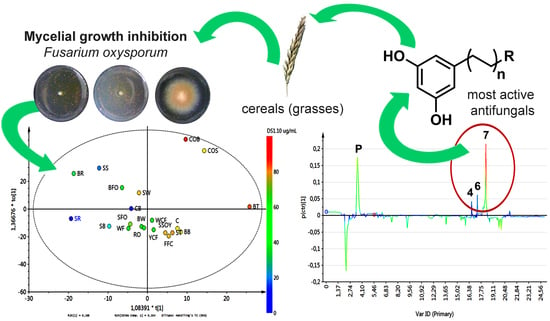Targeted Metabolite Profiling-Based Identification of Antifungal 5-n-Alkylresorcinols Occurring in Different Cereals against Fusarium oxysporum
Abstract
:1. Introduction
2. Results
2.1. Standardization and AR Quantification
2.2. Inhibition of Mycelial Growth on F. oxysporum
2.3. Liquid Chromatography coupled to Electrospray Ionization Mass Spectrometry (LC-ESIMS) Analysis
2.4. Peak Annotation
2.5. Multivariate Analysis
3. Discussion
4. Material and Methods
4.1. Fungal and Plant Material
4.2. Extracts Standardization and Total AR Quantification
4.3. Extraction and Chemical Analyses for Metabolite Profiling
4.3.1. Preparation of AR-Rich Extracts from Different Cereals
4.3.2. High Performance Liquid Chromatography-Electrospray Ionization-Mass Spectrometry (LC-ESI-MS) Analysis
4.3.3. Gas Chromatography-Electron Impact Mass Spectrometry (GC/EIMS) Analysis
4.4. Microscale Amended Medium (MSAM) Assay
4.5. Statistical Analyses
5. Conclusions
Author Contributions
Funding
Conflicts of Interest
Appendix A
| Comp. | HRESIMS a | LRESIMS b | EIMS c |
|---|---|---|---|
| m/z (%), Cluster | m/z (%), Cluster | m/z (%), Fragment | |
| 1 | 389.3028 (85) [M − H]− | 389 (100) | 268 (100) [(TMSO)2C6H4CH2]+ 534 (10) [M + (TMS)2]+ |
| 375.3259 (100), [M − CH2-H]− | |||
| 343.3020 (24), [M − C2H5OH]− | |||
| 2 | 455.3891 (15) [M − H]− | 455(70), [M − H]− | 268 (100) [(TMSO)2C6H4CH2]+ 600 (10) [M + (TMS)2]+ |
| 296 (60) | |||
| 574(50) | |||
| 3 | 347.2976 (100), [M − H]− | 347 (100), [M − H]− | 268 (100) [(TMSO)2C6H4CH2]+ 492 (30) [M + (TMS)2]+ |
| 695.5997 (6), [2M − H]− | 695 (60), [2M − H]− | ||
| 4 | 373.3130 (100), [M − H]− | 373 (100), [M − H]− | 268 (100) [(TMSO)2C6H4CH2]+ 518 (20) [M + (TMS)2]+ |
| 347.2971 (30), [M − C2H2-H]− | 747 (30), [2M − H]− | ||
| 747.6278 (5), [2M − H]− | 398 (10) | ||
| 5 | 375.3289 (100), [M − H]− | 375 (100), [M − H]− | 268 (100) [(TMSO)2C6H4CH2]+ 520 (40) [M + (TMS)2]+ |
| 751.6652 (13), [2M − H]− | 751 (40), [2M − H]− | ||
| 6 | 401.3413 (40), [M − H]− | 401 (100), [M − H]− 803 (15), [2M − H]− | 268 (100) [(TMSO)2C6H4CH2]+ 546 (10) [M + (TMS)2]+ |
| 375.3279 (100), [M − C2H2-H]− | |||
| 803.6830 (5), [2M − H]− | |||
| 7 | 446.3693 (50) [M − H]− | 446 (50), [M − H]− | 268 (80) [(TMSO)2C6H4CH2]+ 591 (30) [M + (TMS)2]+ |
| 1190 (60) | |||
| 8 | 403.3596 (100), [M − H]− | 403 (100), [M − H]− | 268 (100) [(TMSO)2C6H4CH2]+ 548 (30) [M + (TMS)2]+ |
| 807.7275 (45), [2M − H]− | 807 (45), [2M − H]− | ||
| 9 | 415.3187 (80) [M − H]− | 415 (65), [M − H]− | 268 (100) [(TMSO)2C6H4CH2]+ 560 (10) [M + (TMS)2]+ |
| 901 (45) | |||
| 10 | 431.3903 (100), [M − H]− | 431 (100), [M − H]− | 268 (100) [(TMSO)2C6H4CH2]+ 576 (20) [M + (TMS)2]+ |
| 863.7925 (46), [2M − H]− | 863 (46), [2M − H]− | ||
| 11 | 479.3919 (100), [M − H]− | 479 (100), [M − H]− | 268 (100) [(TMSO)2C6H4CH2]+ 624 (15) [M + (TMS)2]+ |
| 343.3036 (51), [M − C10H16-H]− | 959 (37), [2M − H]− | ||
| 12 | 459.4226 (100), [M − H]− | 459 (100), [M − H]− | 268 (100) [(TMSO)2C6H4CH2]+ 604 (20) [M-(TMS)2]+ |
| 919.8549 (40), [2M − H]− | 919 (40), [2M − H]− |
References
- FAO Food and Agriculture Organization of the United Nations. Crop Prospects and Food Situation; Trade and Markets Division of FAO under the Global Information and Early Warning System (GIEWS): Rome, Italy, 2018; pp. 6–8. [Google Scholar]
- Liangli, L.Y.; Tsao, R.; Shahidi, F. Cereals and Pulses: Nutraceutical Properties and Health Benefits; John Wiley & Sons: Chichester, UK, 2012. [Google Scholar]
- Kozubek, A.; Tyman, J.H.P. Resorcinolic lipids, the natural non-isoprenoid phenolic amphiphiles and their biological activity. Chem. Rev. 1999, 99, 1–26. [Google Scholar] [CrossRef] [PubMed]
- Menzel, C.; Kamal-Eldin, A.; Marklund, M.; Andersson, A.; Åman, P.; Landberg, R. Alkylresorcinols in Swedish cereal food products. J. Food Compos. Anal. 2012, 28, 119–125. [Google Scholar] [CrossRef]
- Arendt, E.K.; Zannini, E. 5-Triticale. In Cereal Grains for the Food and Beverage Industries; Woodhead Publishing: Cambridge, UK, 2013; pp. 201–219. [Google Scholar]
- Landberg, R.; Kamal-Eldin, A.; Salmenkallio-Marttila, M.; Rouau, X.; Åman, P. Localization of alkylresorcinols in wheat, rye and barley kernels. J. Cereal. Sci. 2008, 48, 401–406. [Google Scholar] [CrossRef]
- Athukorala, Y.; Hosseinian, F.S.; Mazza, G. Extraction and fractionation of alkylresorcinols from triticale bran by two-step supercritical carbon dioxide. LWT-Food Sci. Technol. 2010, 43, 660–665. [Google Scholar] [CrossRef]
- Gąsiorowski, K.; Szyba, K.; Brokos, B.; Kozubek, A. Antimutagenic activity of alkylresorcinols from cereal grains. Cancer Lett. 1996, 106, 109–115. [Google Scholar] [CrossRef]
- Zarnowski, R.; Kozubek, A. Alkylresorcinol homologs in Pisum sativum L. varieties. Z. Naturforsch 1999, 54, 44–48. [Google Scholar] [CrossRef]
- Stasiuk, M.; Kozubek, A. Biological activity of phenolic lipids. Cell Mol. Life Sci. 2010, 67, 841–860. [Google Scholar] [CrossRef] [PubMed]
- Parikka, K.; Rowland, I.R.; Welch, R.W.; Wähälä, K. In vitro antioxidant activity and antigenotoxicity of 5-n-alkylresorcinols. J. Agric. Food Chem. 2006, 54, 1646–1650. [Google Scholar] [CrossRef]
- Gani, A.; Wani, S.; Masoodi, F.; Hameed, G. Whole-grain cereal bioactive compounds and their health benefits: A review. J. Food Proc. Technol. 2012, 3, 146–156. [Google Scholar] [CrossRef]
- Koistinen, V.M.; Hanhineva, K. Mass spectrometry-based analysis of whole-grain phytochemicals. Crit. Rev. Food Sci. Nutr. 2017, 57, 1688–1709. [Google Scholar] [CrossRef]
- Biskup, I.; Zaczynska, E.; Krauze-Baranowska, M.; Fecka, I. Evaluation of cytotoxicity of 5-n-alkylresorcinol homologs and fraction on mouse fibroblast cell line L929. Eur. Food Res. Technol. 2017, 243, 1137–1148. [Google Scholar] [CrossRef]
- Reiss, J. Influence of alkylresorcinols from rye and related compounds on the growth of food-borne molds. Cereal. Chem. 1989, 66, 491–493. [Google Scholar]
- Dey, E.S.; Ahmadi-Afzadi, M.; Nybom, H.; Tahir, I. Alkylresorcinols isolated from rye bran by supercritical fluid of carbon dioxide and suspended in a food-grade emulsion show activity against Penicillium expansum on apples. Arch. Phytopathol. Plant Protect. 2013, 46, 105–119. [Google Scholar] [CrossRef]
- Tahir, I.; Ahmadi-Afzadi, M.; Nybom, H.; Dey, E. Rye bran alkylresorcinols inhibit growth of Penicillium expansum and Neofabraea perennans in vitro and in vivo on different apple cultivars. Eur. J. Hortic. Sci. 2014, 79, 218–225. [Google Scholar]
- Ciccoritti, R.; Pasquini, M.; Sgrulletta, D.; Nocente, F. Effect of 5-n-alkylresorcinol extracts from durum wheat whole grain on the growth of Fusarium head blight (FHB) causal agents. J. Agric. Food Chem. 2015, 63, 43–50. [Google Scholar] [CrossRef] [PubMed]
- Kienzle, S.; Carle, R.; Sruamsiri, P.; Tosta, C.; Neidhart, S. Occurrence of alk (en) ylresorcinols in the fruits of two mango (Mangifera indica L.) cultivars during on-tree maturation and postharvest storage. J. Agric. Food Chem. 2013, 62, 28–40. [Google Scholar] [CrossRef] [PubMed]
- Karunanayake, K.; Sinniah, G.; Adikaram, N.; Abayasekara, C. Cultivar differences in antifungal activity and the resistance to postharvest anthracnose and stem-end rot in mango (Mangifera indica L). Australas. Plant Pathol. 2014, 43, 151–159. [Google Scholar] [CrossRef]
- Dean, R.; Van Kan, J.A.; Pretorius, Z.A.; Hammond-Kosack, K.E.; Di Pietro, A.; Spanu, P.D.; Rudd, J.J.; Dickman, M.; Kahmann, R.; Ellis, J. The Top 10 fungal pathogens in molecular plant pathology. Mol. Plant. Pathol. 2012, 13, 414–430. [Google Scholar] [CrossRef] [PubMed] [Green Version]
- Plazas-Jiménez, O.; Coy-Barrera, E. Antifungal activity of ultrasound-assisted acetone extract and alkylresorcinol-enriched fractions from Hordeum vulgare L. against Fusarium oxysporum. Cul. Trop. 2016, 37, 173–181. [Google Scholar]
- Carrillo, L. Los Hongos De Los Alimentos Y Forrajes; Universidad Nacional de Salta: Salta, Argentina, 2003. [Google Scholar]
- Summerell, B.A.; Salleh, B.; Leslie, J.F. A utilitarian approach to Fusarium identification. Plant Dis. 2003, 87, 117–128. [Google Scholar] [CrossRef]
- Torres, G.A. Algunos aspectos de los hongos del género Fusarium y de la especie Fusarium oxysporum. Agron. Colomb. 2000, 17, 11–16. [Google Scholar]
- Aoki, T.; O’Donnell, K.; Geiser, D.M. Systematics of key phytopathogenic Fusarium species: Current status and future challenges. J. Gen. Plant Pathol. 2014, 80, 189–201. [Google Scholar] [CrossRef]
- Kellogg, J.J.; Todd, D.A.; Egan, J.M.; Raja, H.A.; Oberlies, N.H.; Kvalheim, O.M.; Cech, N.B. Biochemometrics for natural products research: Comparison of data analysis approaches and application to identification of bioactive compounds. J. Nat. Prod. 2016, 79, 376–386. [Google Scholar] [CrossRef] [PubMed]
- Salek, R.M.; Steinbeck, C.; Viant, M.R.; Goodacre, R.; Dunn, W.B. The role of reporting standards for metabolite annotation and identification in metabolomic studies. GigaScience 2013, 2, 13. [Google Scholar] [CrossRef] [PubMed] [Green Version]
- Sumner, L.W.; Amberg, A.; Barrett, D.; Beale, M.H.; Beger, R.; Daykin, C.A.; Fan, T.W.-M.; Fiehn, O.; Goodacre, R.; Griffin, J.L. Proposed minimum reporting standards for chemical analysis. Metabolomics 2007, 3, 211–221. [Google Scholar] [CrossRef] [PubMed] [Green Version]
- Ross, A.B.; Åman, P.; Andersson, R.; Kamal-Eldin, A. Chromatographic analysis of alkylresorcinols and their metabolites. J. Chromatogr. A 2004, 1054, 157–164. [Google Scholar] [CrossRef]
- Żarnowski, R.; Suzuki, Y.; Yamaguchi, I.; Pietr Stanisław, J. Alkylresorcinols in Barley (Hordeum vulgare L. distichon) Grains. Z. Naturforsch 2002, 57, 57–62. [Google Scholar] [CrossRef]
- Basas-Jaumandreu, J.; López, J.; de las Heras, F.X.C. Resorcinol and m-guaiacol alkylated derivatives and asymmetrical secondary alcohols in the leaves from Tamarix canariensis. Phytochem. Lett. 2014, 10, 240–248. [Google Scholar] [CrossRef]
- Nagy, K.; Ross, A.B.; Fay, L.B.; Bourgeois, A.; Kussmann, M. Gas chromatography/tandem mass spectrometry analysis of alkylresorcinols in red blood cells. Rapid Commun. Mass Spectrom. 2008, 22, 4098–4104. [Google Scholar] [CrossRef]
- Zarnowski, R.; Suzuki, Y. Expedient Soxhlet extraction of resorcinolic lipids from wheat grains. J. Food Compos. Anal. 2004, 17, 649–663. [Google Scholar] [CrossRef]
- Rebolleda, S.; Beltrán, S.; Sanz, M.T.; González-Sanjosé, M.L.; Solaesa, Á.G. Extraction of alkylresorcinols from wheat bran with supercritical CO2. J. Food Eng. 2013, 119, 814–821. [Google Scholar] [CrossRef]
- Ross, A.B.; Shepherd, M.J.; Schüpphaus, M.; Sinclair, V.; Alfaro, B.; Kamal-Eldin, A.; Åman, P. Alkylresorcinols in cereals and cereal products. J. Food Eng. 2003, 51, 4111–4118. [Google Scholar] [CrossRef] [PubMed]
- Pihlava, J.-M.; Hellström, J.; Kurtelius, T.; Mattila, P. Flavonoids, anthocyanins, phenolamides, benzoxazinoids, lignans and alkylresorcinols in rye (Secale cereale) and some rye products. J. Cereal Sci. 2018, 79, 183–192. [Google Scholar] [CrossRef]
- Gohil, S.; Pettersson, D.; Salomonsson, A.-C.; Åman, P. Analysis of alkyl- and alkenylresorcinols in triticale, wheat and rye. J. Sci. Food Agric. 1988, 45, 43–52. [Google Scholar] [CrossRef]
- Hengtrakul, P.; Lorenz, K.; Mathias, M. Alkylresorcinol homologs in cereal grains. J. Food Compos. Anal. 1991, 4, 52–57. [Google Scholar] [CrossRef]
- Al-Ruqaie, I.; Lorenz, K. Alkylresorcinols in extruded cereal brans. Cereal. Chem. 1992, 69, 472. [Google Scholar]
- Barrero, A.F.; Sánchez, J.F.; Rodríguez, I. N-Δ13-Docosenoylanthranilic acid and alkylresorcinols from Ononis natrix subsp. hispanica. Phytochemistry 1990, 29, 1967–1969. [Google Scholar] [CrossRef]
- Garcia, S.; Garcia, C.; Heinzen, H.; Moyna, P. Chemical basis of the resistance of barley seeds to pathogenic fungi. Phytochemistry 1997, 44, 415–418. [Google Scholar] [CrossRef]
- Gembeh, S.V.; Brown, R.L.; Grimm, C.; Cleveland, T.E. Identification of chemical components of corn kernel pericarp wax associated with resistance to Aspergillus flavus infection and aflatoxin production. J. Agric. Food Chem. 2001, 49, 4635–4641. [Google Scholar] [CrossRef]
- Rubert, J.; Righetti, L.; Stranska-Zachariasova, M.; Dzuman, Z.; Chrpova, J.; Dall'Asta, C.; Hajslova, J. Untargeted metabolomics based on ultra-high-performance liquid chromatography–high-resolution mass spectrometry merged with chemometrics: A new predictable tool for an early detection of mycotoxins. Food Chem. 2017, 224, 423–431. [Google Scholar] [CrossRef]
- Mancini, V.; Romanazzi, G. Seed treatments to control seedborne fungal pathogens of vegetable crops. Pest Manag. Sci. 2014, 70, 860–868. [Google Scholar] [CrossRef] [PubMed]
- Sampietro, D.A.; Vattuone, M.A.; Catalán, C.A.N. A new colorimetric method for determination of alkylresorcinols in ground and whole-cereal grains using the diazonium salt Fast Blue RR. Food Chem. 2009, 115, 1170–1174. [Google Scholar] [CrossRef]
Sample Availability: Samples are available from the authors. |
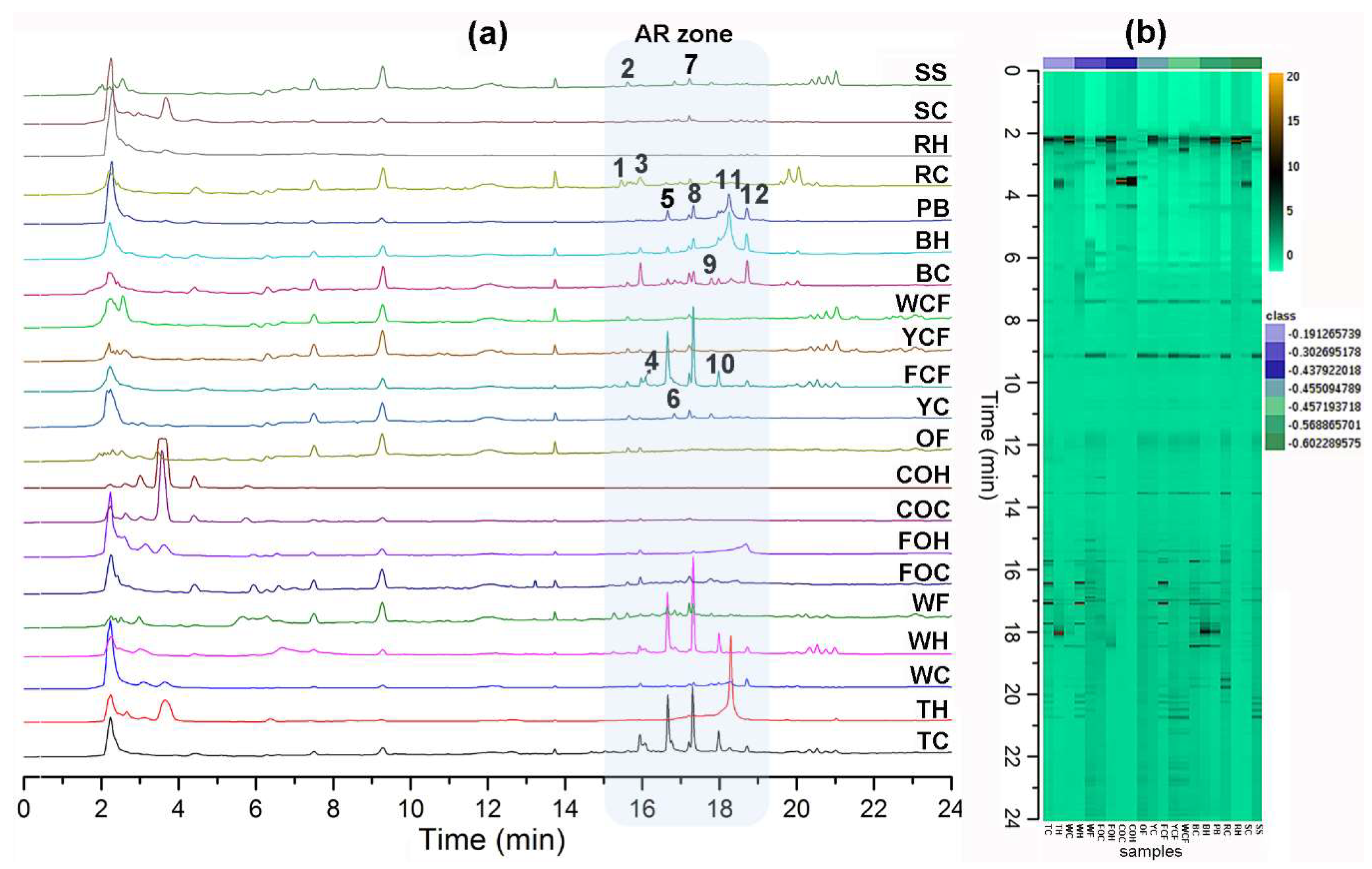
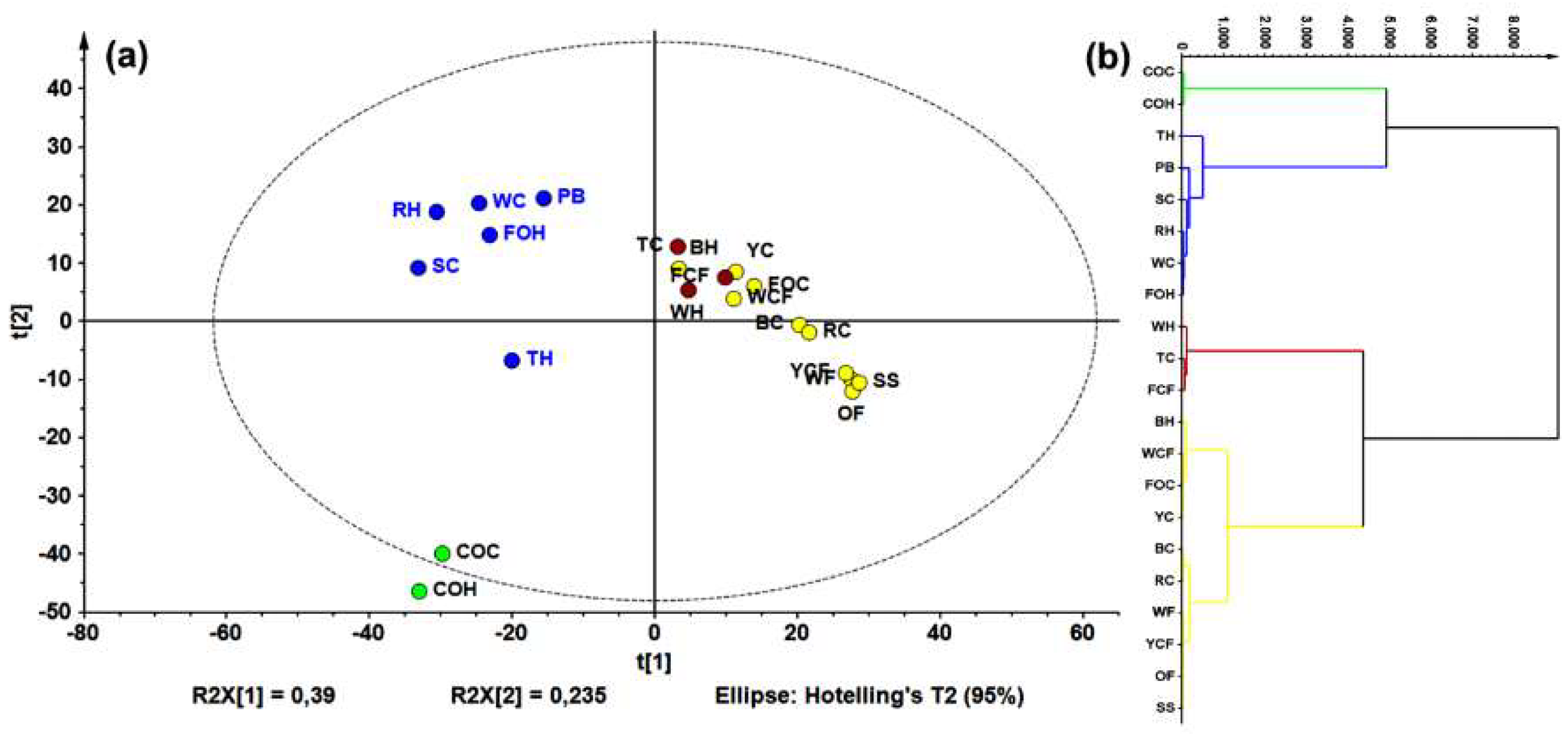
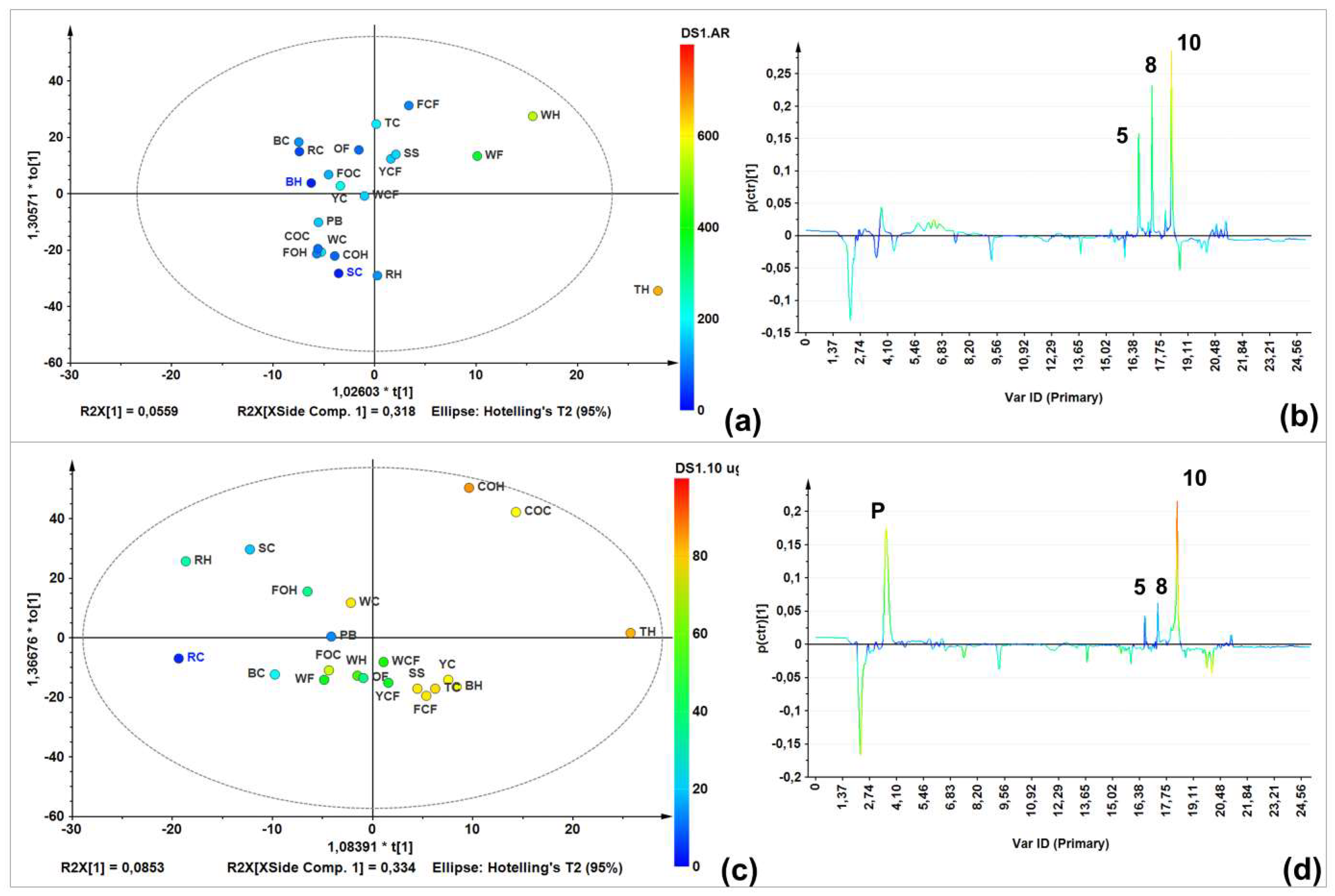
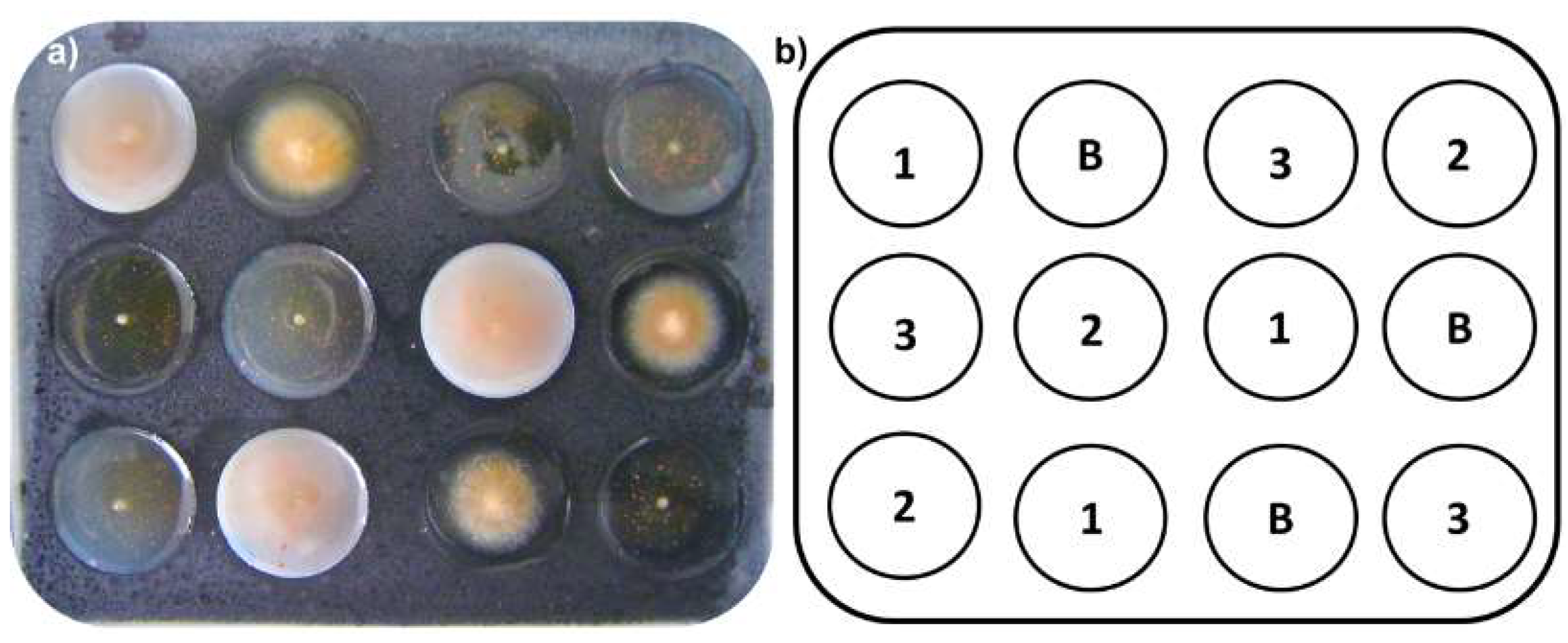
| Solvent | Extraction Yield (%w/w) | Total AR Content a (µg OE/g DE) |
|---|---|---|
| Acetone | 3.9 ± 0.2 B | 706.1 ± 23.2 A |
| Methanol | 6.2 ± 0.4 A | 679.6 ± 32.1 AB |
| n-Hexane | 4.3 ± 0.3 B | 650.5 ± 21.3 B |
| Ethyl acetate | 3.1 ± 0.2 D | 510.7 ± 35.5 C |
| iso-Propanol | 3.5 ± 0.1 C | 497.2 ± 28.6 C |
| Samples | Code | CO a | EY b | TARC c | MGI d (%) | ||
|---|---|---|---|---|---|---|---|
| 10.0 µg/µL | 1.0 µg/µL | 0.1 µg/µL | |||||
| Barley Husk | BH | Co | 0.12 | 24.7 ± 0.5 M | 74.8 ± 1.5 AB | 70.6 ± 1.8 BC | 12.9 ± 1.8 BCD |
| Forage Oat Husk | FOH | Cu | 0.693 | 104.8 ± 3.3 IJ | 36.4 ± 11.3 EF | 17.8 ± 1.6 FG | 19.1 ± 5.6 BC |
| Rice Husk | RH | Co | 0.509 | 115.8 ± 4.2 I | 33.1 ± 1.7 EFG | 16.2 ± 6.2 FG | 11.7 ± 1.4 CD |
| Triticale Husk | TH | Cu | 1.659 | 662.1 ± 20.4 A | 82.5 ± 0.3 AB | 79.4 ± 1.6 AB | 18.8 ± 3.0 BC |
| Wheat Husk | WH | Cu | 1.734 | 541.9 ± 24.7 B | 56.6 ± 2.6 CD | 21.3 ± 0.2 DEF | 26.5 ± 1.2 B |
| Pearl Barley | PB | Co | 0.666 | 156.3 ± 2.4 GH | 13.5 ± 2.3 HI | 11.5 ± 0.4 G | 7.5 ± 7.7 CD |
| Certificate Oat Husk | COH | Co | 0.451 | 81.8 ± 3.7 K | 85.6 ± 0.2 A | 80.7 ± 0.2 A | 80.7 ± 1.4 A |
| Certificate Oat Caryopsis | COC | Co | 0.596 | 86.2 ± 3.0 JK | 75.1 ± 2.9 AB | 65.5 ± 0.1 C | 19.2 ± 1.2 BC |
| Forage Corn Flour | FCF | Co | 0.724 | 103.9 ± 4.4 IJ | 47.7 ± 2.7 DE | 19.9 ± 0.8 EFG | 9.9 ± 1.1 CD |
| Oats Flakes | OF | Co | 0.591 | 85.1 ± 5.2 JK | 36.5 ± 5.7 EF | 23.0 ± 1.2 DEF | 8.2 ± 0.7 CD |
| Barley Caryopsis | BC | Co | 0.648 | 117.5 ± 2.0 I | 25.0 ± 3.2 FGH | 18.9 ± 1.0 EFG | 11.6 ± 0.5 CD |
| Forage Oat Caryopsis | FOC | Cu | 0.796 | 139.2 ± 2.5 H | 69.9 ± 0.6 BC | 16.5 ± 3.0 FG | 11.7 ± 0.1 CD |
| Rice Caryopsis | RC | Co | 0.251 | 56.6 ± 1.4 L | 3.9 ± 0.4 I | 0.0 ± 0.0 H | 0.0 ± 0.0 D |
| Sorghum Caryopsis | SC | Co | 0.146 | 26.2 ± 0.7 M | 19.5 ± 0.3 GH | 16.2 ± 0.8 FG | 10.7 ± 6.6 CD |
| Soy Seed | SS | Cu | 1.039 | 168.2 ± 2.0 EFG | 77.4 ± 0.7 AB | 25.2 ± 0.2 DEF | 13.7 ± 1.7 BCD |
| Triticale Caryopsis | TC | Cu | 0.648 | 185.4 ± 6.9 E | 78.5 ± 3.7 AB | 75.7 ± 4.7 AB | 18.4 ± 2.7 BC |
| Wheat Caryopsis | WC | Cu | 0.688 | 177.5 ± 4.6 EF | 76.9 ± 1.3 AB | 63.4 ± 2.1 C | 11.9 ± 3.9 CD |
| Wheat flour | WF | Co | 1.314 | 363.0 ± 16.8 C | 77.2 ± 4.3 AB | 30.1 ± 4.0 D | 8.4 ± 0.1 CD |
| White Corn Flour | WCF | Co | 1.131 | 162.8 ± 4.6 FG | 52.0 ± 2.1 D | 15.9 ± 0.3 FG | 7.4 ± 5.5 CD |
| Yellow Corn | YC | Cu | 1.131 | 215.7 ± 3.2 D | 75.2 ± 0.7 AB | 27.6 ± 1.9 DE | 15.5 ± 0.5 BC |
| Yellow Corn Flour | YCF | Co | 1.093 | 157.7 ± 5.6 FGH | 46.0 ± 5.6 DE | 23.1 ± 2.1 DEF | 18.6 ± 6.3 BC |
| No | Rt (min) a | [M − H]− (m/z) b | Error (ppm) | Molecular Formula c | Homologue | Name |
|---|---|---|---|---|---|---|
| 1 | 15.4 | 389.3048 | −1.80 | C25H42O3 | C19:1, OH | 5-n-(hydroxynonadecenyl)resorcinol |
| 2 | 15.6 | 455.3896 | 1.54 | C31H52O2 | C25:2 | 5-n-(pentacosadienyl)-resorcinol |
| 3 | 15.9 | 347.2956 | 1.73 | C23H40O2 | C17 | 5-n-heptadecylresorcinol |
| 4 | 16.1 | 373.3113 | 1.88 | C25H42O2 | C19:1 | 5-n-nonadecenylresorcinol |
| 5 | 16.7 | 375.3269 | 1.60 | C25H44O2 | C19 | 5-n-nonadecanylresorcinol |
| 6 | 16.9 | 401.3413 | −1.49 | C27H46O2 | C21:1 | 5-n-henicosenylresorcinol |
| 7 | 17.2 | 445.3693 | 2.69 | C29H50O3 | C23, Oxo | 5-n-(oxotricosanyl)-resorcinol |
| 8 | 17.4 | 403.3586 | 2.48 | C27H48O2 | C21 | 5-n-henicosylresorcinol |
| 9 | 17.7 | 415.3201 | −2.65 | C27H44O3 | C21:1, Oxo | 5-n-(oxoheneicosenyl)-resorcinol |
| 10 | 18.0 | 431.3903 | 3.25 | C29H52O2 | C23 | 5-n-tricosylresorcinol |
| 11 | 18.3 | 479.3899 | 2.09 | C33H52O2 | C27:4 | 5-n-heptacosatetraenylresorcinol |
| 12 | 18.8 | 459.4216 | 3.05 | C31H56O2 | C25 | 5-n-pentacosylresorcinol |
© 2019 by the authors. Licensee MDPI, Basel, Switzerland. This article is an open access article distributed under the terms and conditions of the Creative Commons Attribution (CC BY) license (http://creativecommons.org/licenses/by/4.0/).
Share and Cite
Marentes-Culma, R.; Orduz-Díaz, L.L.; Coy-Barrera, E. Targeted Metabolite Profiling-Based Identification of Antifungal 5-n-Alkylresorcinols Occurring in Different Cereals against Fusarium oxysporum. Molecules 2019, 24, 770. https://doi.org/10.3390/molecules24040770
Marentes-Culma R, Orduz-Díaz LL, Coy-Barrera E. Targeted Metabolite Profiling-Based Identification of Antifungal 5-n-Alkylresorcinols Occurring in Different Cereals against Fusarium oxysporum. Molecules. 2019; 24(4):770. https://doi.org/10.3390/molecules24040770
Chicago/Turabian StyleMarentes-Culma, Ronald, Luisa L. Orduz-Díaz, and Ericsson Coy-Barrera. 2019. "Targeted Metabolite Profiling-Based Identification of Antifungal 5-n-Alkylresorcinols Occurring in Different Cereals against Fusarium oxysporum" Molecules 24, no. 4: 770. https://doi.org/10.3390/molecules24040770
APA StyleMarentes-Culma, R., Orduz-Díaz, L. L., & Coy-Barrera, E. (2019). Targeted Metabolite Profiling-Based Identification of Antifungal 5-n-Alkylresorcinols Occurring in Different Cereals against Fusarium oxysporum. Molecules, 24(4), 770. https://doi.org/10.3390/molecules24040770





